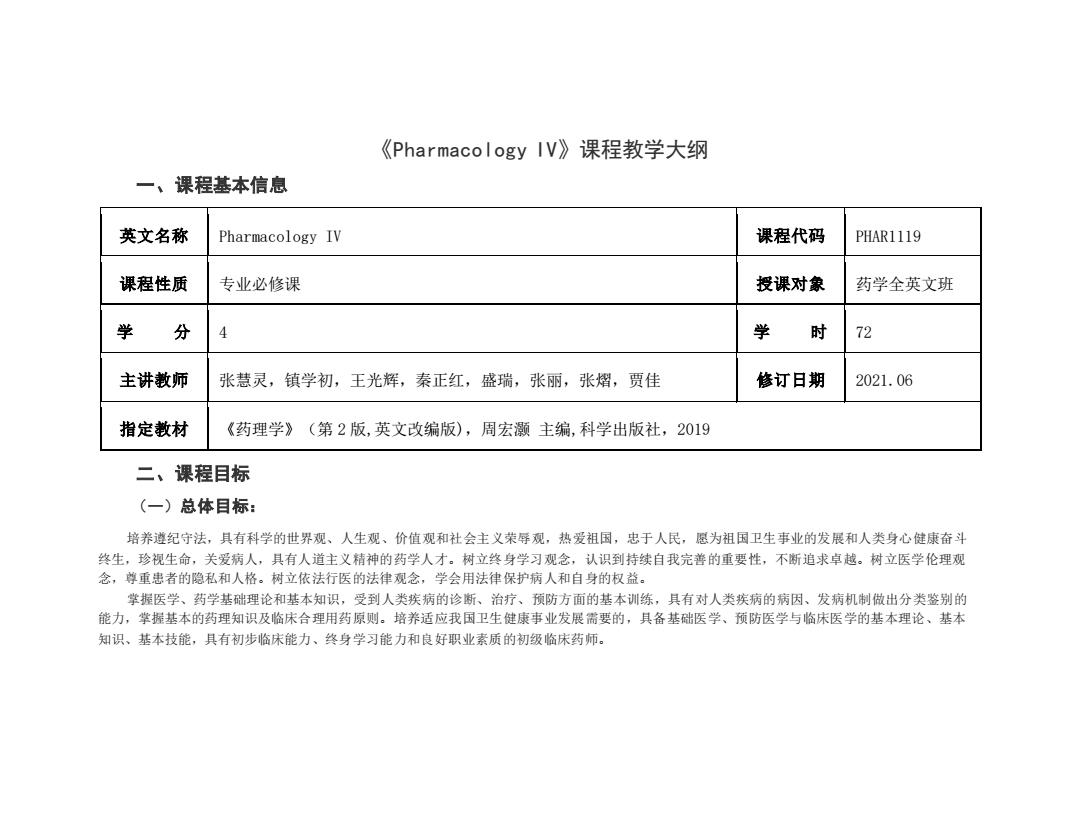
《Pharmacology IV)》课程教学大纲 一、课程基本信息 英文名称 Pharmacology IV 课程代码 PHAR1119 课程性质 专业必修课 授课对象 药学全英文班 学 分 4 学 时 72 主讲教师 张慧灵,镇学初,王光辉,秦正红,盛瑞,张丽,张熠,贾佳 修订日期 2021.06 指定教材 《药理学》(第2版,英文改编版),周宏灏主编,科学出版社,2019 二、课程目标 (一)总体目标: 培养遵纪守法,具有科学的世界观、人生观、价值观和社会主义荣辱观,热爱祖国,忠于人民,恩为祖国卫生事业的发展和人类身心健康奋斗 终生,珍视生命,关爱病人,具有人道主义精神的药学人才。树立终身学习观念,认识到持续自我完善的重要性,不断追求卓越。树立医学伦理观 念,尊重患者的隐私和人格。树立依法行医的法律观念,学会用法律保护病人和自身的权益。 掌握医学、药学基础理论和基本知识,受到人类疾病的诊断、治疗、预防方面的基本训练,具有对人类疾病的病因、发病机制做出分类鉴别的 能力,掌握基本的药理知识及临床合理用药原则。培养适应我国卫生健康事业发展需要的,具备基础医学、预防医学与临床医学的基本理论、基本 知识、基本技能,具有初步临床能力、终身学习能力和良好职业素质的初级临床药师
《Pharmacology IV》课程教学大纲 一、课程基本信息 英文名称 Pharmacology IV 课程代码 PHAR1119 课程性质 专业必修课 授课对象 药学全英文班 学 分 4 学 时 72 主讲教师 张慧灵,镇学初,王光辉,秦正红,盛瑞,张丽,张熠,贾佳 修订日期 2021.06 指定教材 《药理学》(第 2 版,英文改编版),周宏灏 主编,科学出版社,2019 二、课程目标 (一)总体目标: 培养遵纪守法,具有科学的世界观、人生观、价值观和社会主义荣辱观,热爱祖国,忠于人民,愿为祖国卫生事业的发展和人类身心健康奋斗 终生,珍视生命,关爱病人,具有人道主义精神的药学人才。树立终身学习观念,认识到持续自我完善的重要性,不断追求卓越。树立医学伦理观 念,尊重患者的隐私和人格。树立依法行医的法律观念,学会用法律保护病人和自身的权益。 掌握医学、药学基础理论和基本知识,受到人类疾病的诊断、治疗、预防方面的基本训练,具有对人类疾病的病因、发病机制做出分类鉴别的 能力,掌握基本的药理知识及临床合理用药原则。培养适应我国卫生健康事业发展需要的,具备基础医学、预防医学与临床医学的基本理论、基本 知识、基本技能,具有初步临床能力、终身学习能力和良好职业素质的初级临床药师
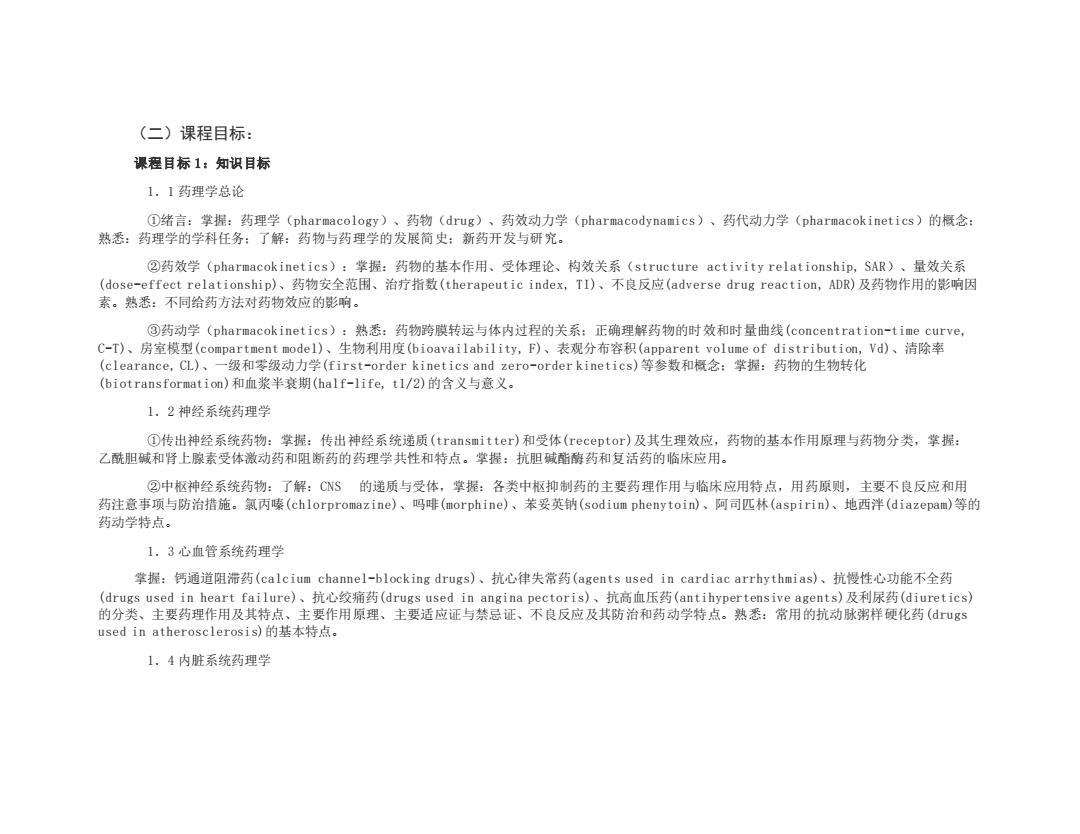
(二)课程目标: 课程目标1:知识目标 1.1药理学总论 ①绪言:掌握:药理学(pharmacology)、药物(drug)、药效动力学(pharmacodynamics)、药代动力学(pharmacokinetics)的概念: 熟悉:药理学的学科任务:了解:药物与药理学的发展简史:新药开发与研究。 ②药效学(pharmacokinetics):学握:药物的基本作用、受体理论、构效关系(structure activity relationship,SAR)、量效关系 (dose-effect relationship)、药物安全范围、治疗指数(therapeutic index,TI)、不良反应(adverse drug reaction,ADR)及药物作用的影响因 素。熟悉:不同给药方法对药物效应的影响。 ③药动学(pharmacokinetics):熟悉:药物跨膜转运与体内过程的关系:正确理解药物的时效和时量曲线(concentration-time curve, C-T)、房室模型(compartment model)、生物利用度(bioavailability,F)、表观分布容积(apparent volume of distribution,Vd)、请除率 (clearance,CL)、一级和零级动力学(first-order kinetics and zero-order kinetics)等参数和概念:掌握:药物的生物转化 (biotransformation)和血浆半衰期(half-life,tl/2)的含义与意义。 1.2神经系统药理学 ①传出神经系统药物:掌握:传出神经系统递质(transmitter)和受体(receptor)及其生理效应,药物的基本作用原理与药物分类,掌握: 乙酰胆碱和肾上腺素受体激动药和阻断药的药理学共性和特点。掌握:抗胆碱酯酶药和复活药的临床应用。 ②中枢神经系统药物:了解:CN$的递质与受体,掌握:各类中枢抑制药的主要药理作用与临床应用特点,用药原则,主要不良反应和用 药注意事项与防治措施。氯丙嗪(chlorpromazine)、吗啡(morphine)、苯妥英钠(sodium phenytoin)、阿司匹林(aspirin)、地西泮(diazepam)等的 药动学特点。 1.3心血管系统药理学 掌握:钙通道阻滞药(calcium channel-blocking drugs).、抗心律失常药(agents used in cardiac arrhythmias)、抗慢性心功能不全药 (drugs used in heart failure)、抗心绞痛药(drugs used in angina pectoris)、抗高血压药(antihypertensive agents)及利尿药(diuretics) 的分类、主要药理作用及其特点、主要作用原理、主要适应证与禁忌证、不良反应及其防治和药动学特点。熟悉:常用的抗动脉粥样硬化药(ugs used in atherosclerosis)的基本特点。 1.4内脏系统药理学
(二)课程目标: 课程目标 1:知识目标 1.1 药理学总论 ①绪言:掌握:药理学(pharmacology)、药物(drug)、药效动力学(pharmacodynamics)、药代动力学(pharmacokinetics)的概念; 熟悉:药理学的学科任务;了解:药物与药理学的发展简史;新药开发与研究。 ②药效学(pharmacokinetics):掌握:药物的基本作用、受体理论、构效关系(structure activity relationship, SAR)、量效关系 (dose-effect relationship)、药物安全范围、治疗指数(therapeutic index, TI)、不良反应(adverse drug reaction, ADR)及药物作用的影响因 素。熟悉:不同给药方法对药物效应的影响。 ③药动学(pharmacokinetics):熟悉:药物跨膜转运与体内过程的关系;正确理解药物的时效和时量曲线(concentration-time curve, C-T)、房室模型(compartment model)、生物利用度(bioavailability, F)、表观分布容积(apparent volume of distribution, Vd)、清除率 (clearance, CL)、一级和零级动力学(first-order kinetics and zero-order kinetics)等参数和概念;掌握:药物的生物转化 (biotransformation)和血浆半衰期(half-life, t1/2)的含义与意义。 1.2 神经系统药理学 ①传出神经系统药物:掌握:传出神经系统递质(transmitter)和受体(receptor)及其生理效应,药物的基本作用原理与药物分类,掌握: 乙酰胆碱和肾上腺素受体激动药和阻断药的药理学共性和特点。掌握:抗胆碱酯酶药和复活药的临床应用。 ②中枢神经系统药物:了解:CNS 的递质与受体,掌握:各类中枢抑制药的主要药理作用与临床应用特点,用药原则,主要不良反应和用 药注意事项与防治措施。氯丙嗪(chlorpromazine)、吗啡(morphine)、苯妥英钠(sodium phenytoin)、阿司匹林(aspirin)、地西泮(diazepam)等的 药动学特点。 1.3 心血管系统药理学 掌握:钙通道阻滞药(calcium channel-blocking drugs)、抗心律失常药(agents used in cardiac arrhythmias)、抗慢性心功能不全药 (drugs used in heart failure)、抗心绞痛药(drugs used in angina pectoris)、抗高血压药(antihypertensive agents)及利尿药(diuretics) 的分类、主要药理作用及其特点、主要作用原理、主要适应证与禁忌证、不良反应及其防治和药动学特点。熟悉:常用的抗动脉粥样硬化药(drugs used in atherosclerosis)的基本特点。 1.4 内脏系统药理学
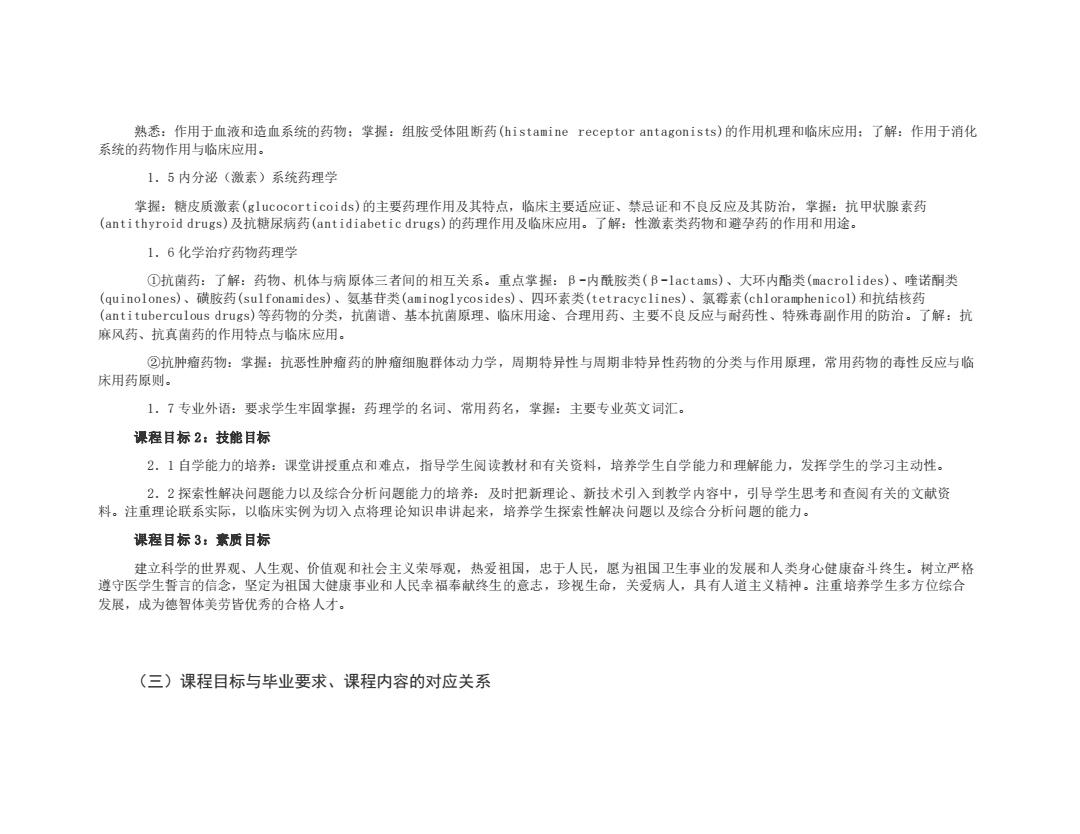
熟悉:作用于血液和造血系统的药物:掌握:组胺受体阻断药(histamine receptor antagonists)的作用机理和临床应用:了解:作用于消化 系统的药物作用与临床应用。 1.5内分泌(激素)系统药理学 掌握:糖皮质激素(g1 ucocorticoids)的主要药理作用及其特点,临床主要适应证、禁忌证和不良反应及其防治,掌握:抗甲状腺素药 (antithyroid drugs)及抗糖尿病药(antidiabetic drugs)的药理作用及临床应用。了解:性激素类药物和避孕药的作用和用途。 1.6化学治疗药物药理学 ①抗菌药:了解:药物、机体与病原体三者间的相互关系。重点学握:B-内酰胺类(B-lactams)、大环内酯类(macrolides)、喹诺酮类 (quinolones).、磺胺药(sulfonamides)、氨基苷类(aminoglycosides)、四环素类(tetracyclines)、氯霉素(chloramphenicol)和抗结核药 (antituberculous drugs).等药物的分类,抗菌谱、基本抗菌原理、临床用途、合理用药、主要不良反应与耐药性、特殊毒副作用的防治。了解:抗 麻风药、抗真菌药的作用特点与临床应用。 ②抗肿瘤药物:掌提:抗恶性肿瘤药的肿瘤细胞群体动力学,周期特异性与周期非特异性药物的分类与作用原理,常用药物的毒性反应与临 床用药原则。 1.7专业外语:要求学生牢固掌握:药理学的名词、常用药名,掌握:主要专业英文词汇。 禄程目标2:技能目标 2.1自学能力的培养:课堂讲授重点和难点,指导学生阅读教材和有关资料,培养学生自学能力和理解能力,发挥学生的学习主动性。 2.2探索性解决问题能力以及综合分析问题能力的培养:及时把新理论、新技术引入到教学内容中,引导学生思考和查阅有关的文献资 料。注重理论联系实际,以临床实例为切入点将理论知识串讲起来,培养学生探索性解决问题以及综合分析问题的能力。 课程目标3:素质目标 建立科学的世界观、人生观、价值观和社会主义荣辱观,热爱祖国,忠于人民,愿为祖国卫生事业的发展和人类身心健康奋斗终生。树立严格 遵守医学生誓言的信念,坚定为祖国大健康事业和人民幸福奉献终生的意志,珍视生命,关爱病人,具有人道主义精神。注重培养学生多方位综合 发展,成为德智体美劳皆优秀的合格人才。 (三)课程目标与毕业要求、课程内容的对应关系
熟悉:作用于血液和造血系统的药物;掌握:组胺受体阻断药(histamine receptor antagonists)的作用机理和临床应用;了解:作用于消化 系统的药物作用与临床应用。 1.5 内分泌(激素)系统药理学 掌握:糖皮质激素(glucocorticoids)的主要药理作用及其特点,临床主要适应证、禁忌证和不良反应及其防治,掌握:抗甲状腺素药 (antithyroid drugs)及抗糖尿病药(antidiabetic drugs)的药理作用及临床应用。了解:性激素类药物和避孕药的作用和用途。 1.6 化学治疗药物药理学 ①抗菌药:了解:药物、机体与病原体三者间的相互关系。重点掌握:β-内酰胺类(β-lactams)、大环内酯类(macrolides)、喹诺酮类 (quinolones)、磺胺药(sulfonamides)、氨基苷类(aminoglycosides)、四环素类(tetracyclines)、氯霉素(chloramphenicol)和抗结核药 (antituberculous drugs)等药物的分类,抗菌谱、基本抗菌原理、临床用途、合理用药、主要不良反应与耐药性、特殊毒副作用的防治。了解:抗 麻风药、抗真菌药的作用特点与临床应用。 ②抗肿瘤药物:掌握:抗恶性肿瘤药的肿瘤细胞群体动力学,周期特异性与周期非特异性药物的分类与作用原理,常用药物的毒性反应与临 床用药原则。 1.7 专业外语:要求学生牢固掌握:药理学的名词、常用药名,掌握:主要专业英文词汇。 课程目标 2:技能目标 2.1 自学能力的培养:课堂讲授重点和难点,指导学生阅读教材和有关资料,培养学生自学能力和理解能力,发挥学生的学习主动性。 2.2 探索性解决问题能力以及综合分析问题能力的培养:及时把新理论、新技术引入到教学内容中,引导学生思考和查阅有关的文献资 料。注重理论联系实际,以临床实例为切入点将理论知识串讲起来,培养学生探索性解决问题以及综合分析问题的能力。 课程目标 3:素质目标 建立科学的世界观、人生观、价值观和社会主义荣辱观,热爱祖国,忠于人民,愿为祖国卫生事业的发展和人类身心健康奋斗终生。树立严格 遵守医学生誓言的信念,坚定为祖国大健康事业和人民幸福奉献终生的意志,珍视生命,关爱病人,具有人道主义精神。注重培养学生多方位综合 发展,成为德智体美劳皆优秀的合格人才。 (三)课程目标与毕业要求、课程内容的对应关系
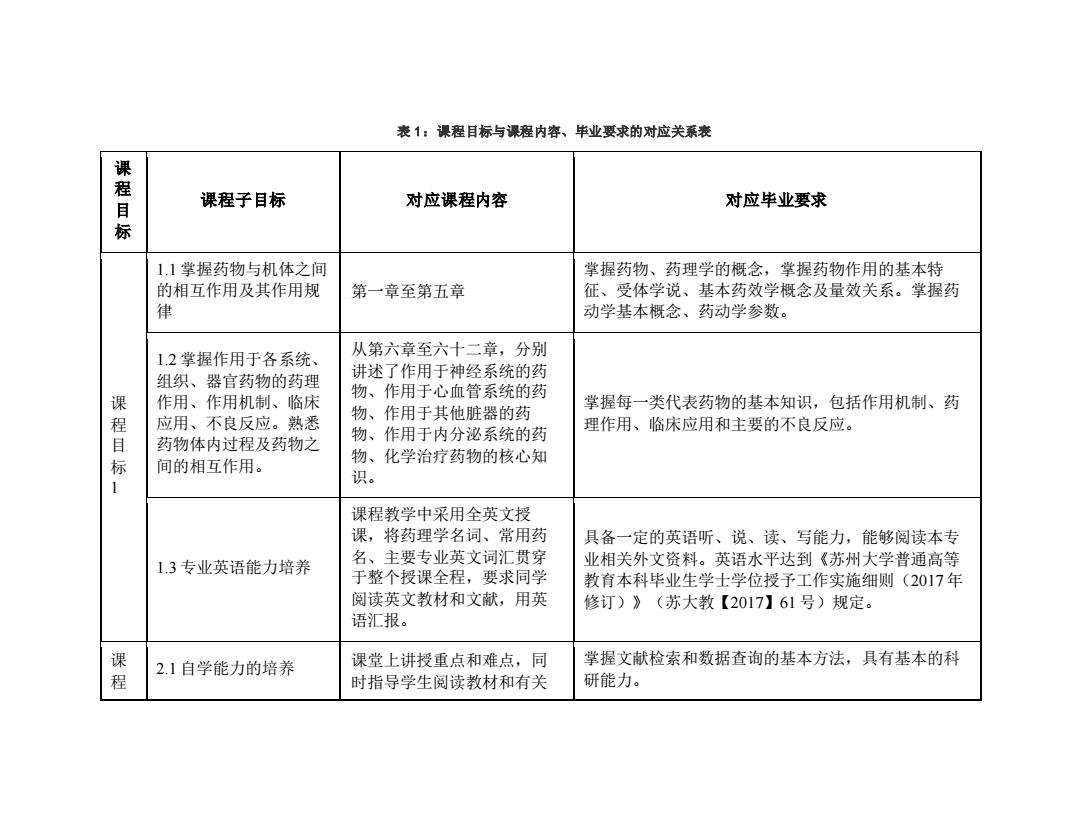
表1:课程目标与课程内容、毕业要求的对应关系表 课程目标 课程子目标 对应课程内容 对应毕业要求 1.1掌握药物与机体之间 掌握药物、药理学的概念,掌握药物作用的基本特 的相互作用及其作用规 第一章至第五章 征、受体学说、基本药效学概念及量效关系。掌握药 律 动学基本概念、药动学参数。 1.2掌握作用于各系统、 从第六章至六十二章,分别 组织、器官药物的药理 讲述了作用于神经系统的药 物、作用于心血管系统的药 课 作用、作用机制、临床 物、作用于其他脏器的药 掌握每一类代表药物的基本知识,包括作用机制、药 程 应用、不良反应。熟悉 物、作用于内分泌系统的药 理作用、临床应用和主要的不良反应。 目 药物体内过程及药物之 标 间的相互作用。 物、化学治疗药物的核心知 识。 课程教学中采用全英文授 课,将药理学名词、常用药 具备一定的英语听、说、读、写能力,能够阅读本专 1.3专业英语能力培养 名、主要专业英文词汇贯穿 业相关外文资料。英语水平达到《苏州大学普通高等 于整个授课全程,要求同学 教育本科毕业生学士学位授予工作实施细则(2017年 阅读英文教材和文献,用英 修订)》(苏大教【2017】61号)规定。 语汇报。 程 2.1自学能力的培养 课堂上讲授重点和难点,同 掌握文献检索和数据查询的基本方法,具有基本的科 时指导学生阅读教材和有关 研能力
表 1:课程目标与课程内容、毕业要求的对应关系表 课 程 目 标 课程子目标 对应课程内容 对应毕业要求 课 程 目 标 1 1.1 掌握药物与机体之间 的相互作用及其作用规 律 第一章至第五章 掌握药物、药理学的概念,掌握药物作用的基本特 征、受体学说、基本药效学概念及量效关系。掌握药 动学基本概念、药动学参数。 1.2 掌握作用于各系统、 组织、器官药物的药理 作用、作用机制、临床 应用、不良反应。熟悉 药物体内过程及药物之 间的相互作用。 从第六章至六十二章,分别 讲述了作用于神经系统的药 物、作用于心血管系统的药 物、作用于其他脏器的药 物、作用于内分泌系统的药 物、化学治疗药物的核心知 识。 掌握每一类代表药物的基本知识,包括作用机制、药 理作用、临床应用和主要的不良反应。 1.3 专业英语能力培养 课程教学中采用全英文授 课,将药理学名词、常用药 名、主要专业英文词汇贯穿 于整个授课全程,要求同学 阅读英文教材和文献,用英 语汇报。 具备一定的英语听、说、读、写能力,能够阅读本专 业相关外文资料。英语水平达到《苏州大学普通高等 教育本科毕业生学士学位授予工作实施细则(2017 年 修订)》(苏大教【2017】61 号)规定。 课 程 2.1 自学能力的培养 课堂上讲授重点和难点,同 时指导学生阅读教材和有关 掌握文献检索和数据查询的基本方法,具有基本的科 研能力
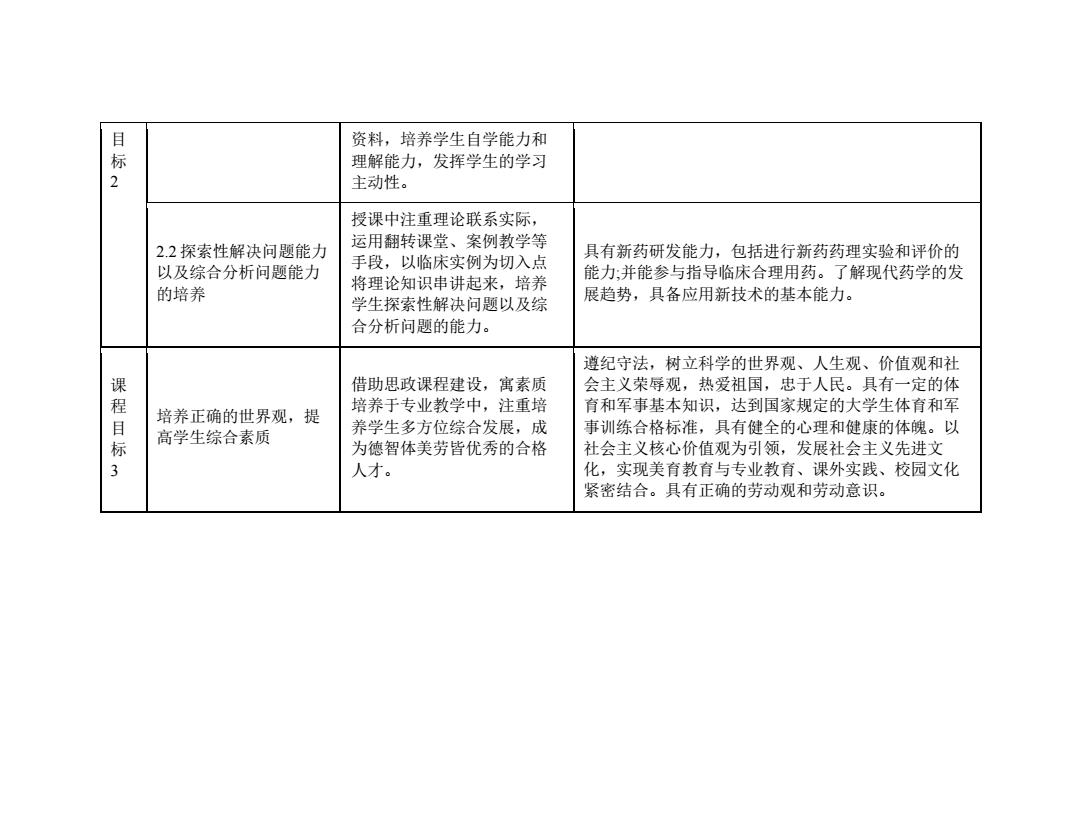
资料,培养学生自学能力和 理解能力,发挥学生的学习 2 主动性。 授课中注重理论联系实际, 2.2探索性解决问题能力 运用翻转课堂、案例教学等 具有新药研发能力,包括进行新药药理实验和评价的 以及综合分析问题能力 手段,以临床实例为切入点 能力:并能参与指导临床合理用药。了解现代药学的发 的培养 将理论知识串讲起来,培养 学生探索性解决问题以及综 展趋势,具备应用新技术的基本能力。 合分析问题的能力。 遵纪守法,树立科学的世界观、人生观、价值观和社 借助思政课程建设,寓素质 课程目 会主义荣辱观,热爱祖国,忠于人民。具有一定的体 培养于专业教学中,注重培 育和军事基本知识,达到国家规定的大学生体育和军 培养正确的世界观,提 养学生多方位综合发展,成 事训练合格标准,具有健全的心理和健康的体魄。以 高学生综合素质 为德智体美劳皆优秀的合格 社会主义核心价值观为引领,发展社会主义先进文 3 人才。 化,实现美育教育与专业教育、课外实践、校园文化 紧密结合。具有正确的劳动观和劳动意识
目 标 2 资料,培养学生自学能力和 理解能力,发挥学生的学习 主动性。 2.2 探索性解决问题能力 以及综合分析问题能力 的培养 授课中注重理论联系实际, 运用翻转课堂、案例教学等 手段,以临床实例为切入点 将理论知识串讲起来,培养 学生探索性解决问题以及综 合分析问题的能力。 具有新药研发能力,包括进行新药药理实验和评价的 能力;并能参与指导临床合理用药。了解现代药学的发 展趋势,具备应用新技术的基本能力。 课 程 目 标 3 培养正确的世界观,提 高学生综合素质 借助思政课程建设,寓素质 培养于专业教学中,注重培 养学生多方位综合发展,成 为德智体美劳皆优秀的合格 人才。 遵纪守法,树立科学的世界观、人生观、价值观和社 会主义荣辱观,热爱祖国,忠于人民。具有一定的体 育和军事基本知识,达到国家规定的大学生体育和军 事训练合格标准,具有健全的心理和健康的体魄。以 社会主义核心价值观为引领,发展社会主义先进文 化,实现美育教育与专业教育、课外实践、校园文化 紧密结合。具有正确的劳动观和劳动意识

3. 教学内容 Chapter 1 Introduction 1.Teaching Objectives 1.1 To leam the definition ofdrug,pharmacology,pharmacodynamicsand pharmacokinetics. 1.2 To leam the principles ofdrug nomenclature. 1.3 To understand the developmentalhistory ofpharmacology. 2.Teaching main and difficult points The definitions and relationships between pharmacology and the two relevant displines of pharmacodynamics and pharmacokinetics. 3.Course Contents 3.1 The definitions and relationships between pharmacology and the two relevant disciplines of pharmacodynamicsand pharmacokinetics. 3.2 The developmentalhistory of pharmacology. 3.3 The definition and clinical applications of drugs. 3.4 Therapeutic,adverse,and toxic effects of drugs. 3.5 Principles ofdrug nomenclature. 3.6 Suggestions for pharmacology study. 4.Teaching Methods By using multimedia teaching method,off-line,on-line method,student-centered method and other diversified teaching methods,we inspire students to "leam with questions"and cultivate students'critical thinking ability. 5.Teaching Evaluation 5.1 Discussion What is drug?What is the relationship between pharmacodynamics and pharmacokinetics? 5.2 Questions
3. 教学内容 Chapter 1 Introduction 1.Teaching Objectives 1.1 To learn the definition of drug, pharmacology, pharmacodynamics and pharmacokinetics. 1.2 To learn the principles of drug nomenclature. 1.3 To understand the developmental history of pharmacology. 2.Teaching main and difficult points The definitions and relationships between pharmacology and the two relevant displines of pharmacodynamics and pharmacokinetic s. 3. Course Contents 3.1 The definitions and relationships between pharmacology and the two relevant discip lines of pharmacodynamics and pharmacokinetics. 3.2 The developmental history of pharmacology. 3.3 The definition and clinical applications of drugs. 3.4 Therapeutic, adverse, and toxic effects of drugs. 3.5 Principles of drug nomenclature. 3.6 Suggestions for pharmacology study. 4.Teaching Methods By using multimedia teaching method, off-line, on-line method, student-centered method and other diversified teaching methods, we inspire students to "learn with questions" and cultivate students' critical thinking ability. 5.Teaching Evaluation 5.1 Discussion What is drug? What is the relationship between pharmacodynamics and pharmacokinetics? 5.2 Questions
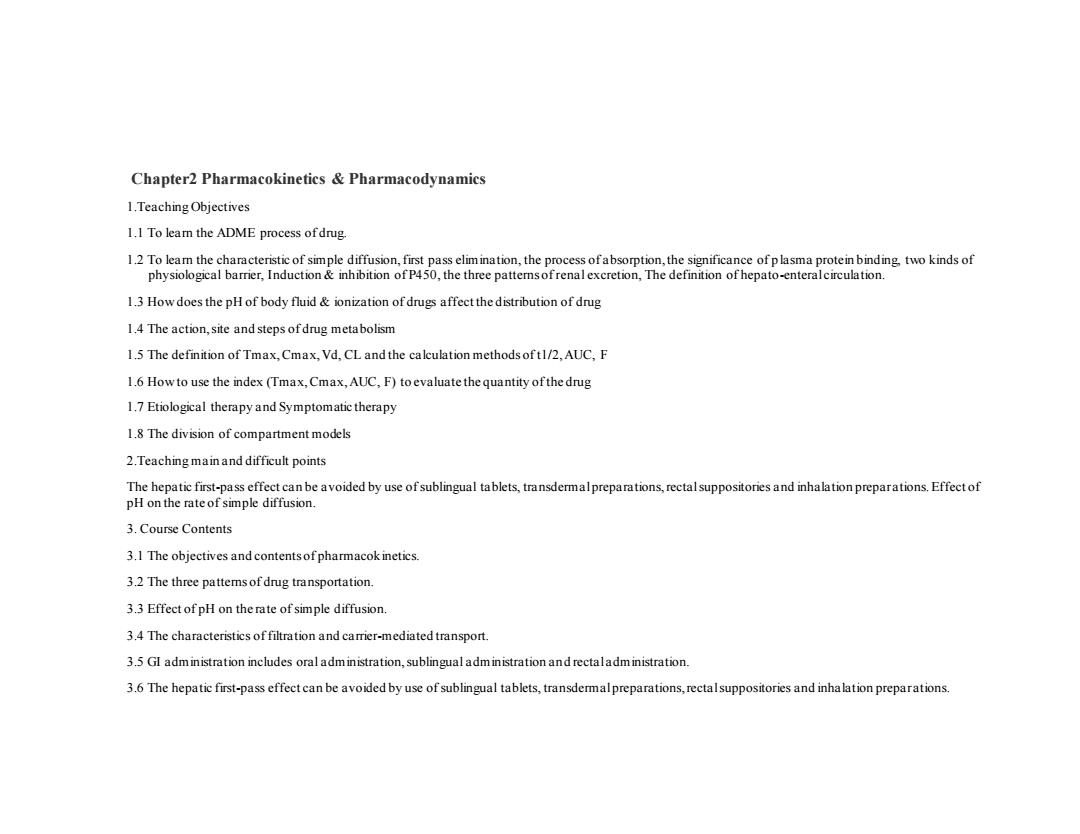
Chapter2 Pharmacokinetics Pharmacodynamics 1.Teaching Objectives 1.1 To learn the ADME process ofdrug. 1.2 To leam the characteristic of simple diffusion,first pass elimination,the process ofabsorption,the significance ofp lasma protein binding,two kinds of physiological barrier,Induction inhibition of P450,the three patternsofrenal excretion,The definition of hepato-enteralcirculation. 1.3 How does the pH of body fluid ionization of drugs affect the distribution of drug 1.4 The action,site and steps of drug metabolism 1.5 The definition of Tmax,Cmax,Vd,CL and the calculation methods oft1/2,AUC,F 1.6 How to use the index (Tmax,Cmax,AUC,F)to evaluate the quantity ofthe drug 1.7 Etiological therapy and Symptomatic therapy 1.8 The division of compartment models 2.Teaching main and difficult points The hepatic first-pass effect can be avoided by use of sublingual tablets,transdermalpreparations,rectal suppositories and inhalation preparations.Effect of pH on the rate of simple diffusion. 3.Course Contents 3.1 The objectives and contents of pharmacok inetics. 3.2 The three patterns of drug transportation. 3.3 Effect of pH on the rate of simple diffusion. 3.4 The characteristics of filtration and carrier-mediated transport. 3.5 GI administration includes oral administration,sublingual adm inistration and rectaladministration. 3.6 The hepatic first-pass effect can be avoided by use of sublingual tablets,transdermalpreparations,rectalsuppositories and inhalation preparations
Chapter2 Pharmacokinetics & Pharmacodynamics 1.Teaching Objectives 1.1 To learn the ADME process of drug. 1.2 To learn the characteristic of simple diffusion, first pass elimination, the process of absorption, the significance of p lasma protein binding, two kinds of physiological barrier, Induction & inhibition of P450, the three patterns of renal excretion, The definition of hepato-enteral circulation. 1.3 How does the pH of body fluid & ionization of drugs affect the distribution of drug 1.4 The action, site and steps of drug metabolism 1.5 The definition of Tmax, Cmax, Vd, CL and the calculation methods of t1/2, AUC, F 1.6 How to use the index (Tmax, Cmax, AUC, F) to evaluate the quantity of the drug 1.7 Etiological therapy and Symptomatic therapy 1.8 The division of compartment models 2.Teaching main and difficult points The hepatic first-pass effect can be avoided by use of sublingual tablets, transdermal preparations, rectal suppositories and inhalation preparations. Effect of pH on the rate of simple diffusion. 3. Course Contents 3.1 The objectives and contents of pharmacokinetics. 3.2 The three patterns of drug transportation. 3.3 Effect of pH on the rate of simple diffusion. 3.4 The characteristics of filtration and carrier-mediated transport. 3.5 GI administration includes oral administration, sublingual administration and rectal administration. 3.6 The hepatic first-pass effect can be avoided by use of sublingual tablets, transdermal preparations, rectal suppositories and inhalation preparations
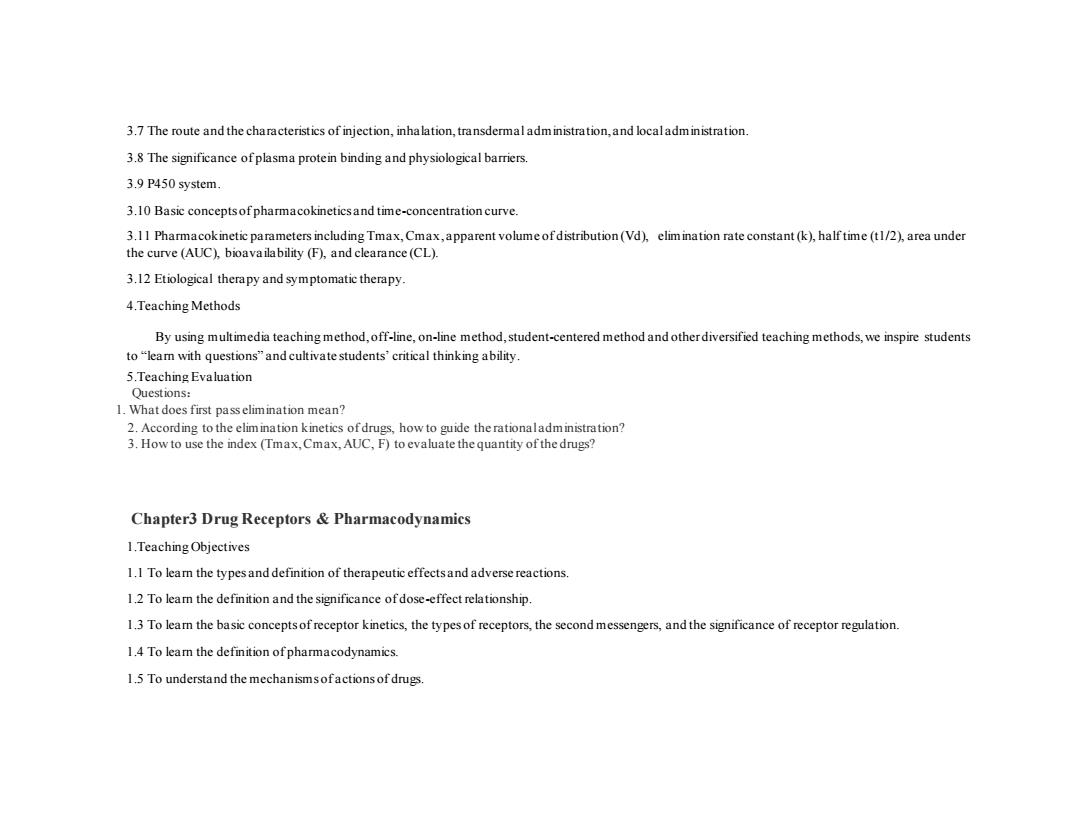
3.7 The route and the characteristics of injection,inhalation,transdermal administration,and localadministration. 3.8 The significance ofplasma protein binding and physiological barriers. 3.9 P450 system. 3.10 Basic conceptsofpharmacokineticsand time-concentration curve. 3.11 Pharmacokinetic parameters including Tmax,Cmax,apparent volume ofdistribution(Vd),elimination rate constant(k),halftime(t1/2),area under the curve (AUC),bioavailability (F),and clearance(CL). 3.12 Etiological therapy and symptomatic therapy 4.Teaching Methods By using multimedia teaching method,off-line,on-line method,student-centered method and otherdiversified teaching methods,we inspire students to"leam with questions"and cultivate students'critical thinking ability. 5.Teaching Evaluation Questions: 1.What does first pass elimination mean? 2.According to the elimination kinetics of drugs,how to guide the rationaladministration? 3.How to use the index(Tmax,Cmax,AUC,F)to evaluate the quantity of the drugs? Chapter3 Drug Receptors Pharmacodynamics 1.Teaching Objectives 1.I To leam the types and definition of therapeutic effectsand adverse reactions. 1.2 To learn the definition and the significance ofdose-effect relationship. 1.3 To learn the basic conceptsof receptor kinetics,the types of receptors,the second messengers,and the significance of receptor regulation. 1.4 To learn the definition ofpharmacodynamics. 1.5 To understand the mechanismsofactions of drugs
3.7 The route and the characteristics of injection, inhalation, transdermal administration, and local administration. 3.8 The significance of plasma protein binding and physiological barriers. 3.9 P450 system. 3.10 Basic concepts of pharmacokinetics and time-concentration curve. 3.11 Pharmacokinetic parameters including Tmax, Cmax, apparent volume of distribution (Vd), elimination rate constant (k), half time (t1/2), area under the curve (AUC), bioavailability (F), and clearance (CL). 3.12 Etiological therapy and symptomatic therapy. 4.Teaching Methods By using multimedia teaching method, off-line, on-line method, student-centered method and other diversified teaching methods, we inspire students to “learn with questions” and cultivate students’ critical thinking ability. 5.Teaching Evaluation Questions: 1. What does first pass elimination mean? 2. According to the elimination kinetics of drugs, how to guide the rational administration? 3. How to use the index (Tmax, Cmax, AUC, F) to evaluate the quantity of the drugs? Chapter3 Drug Receptors & Pharmacodynamics 1.Teaching Objectives 1.1 To learn the types and definition of therapeutic effects and adverse reactions. 1.2 To learn the definition and the significance of dose-effect relationship. 1.3 To learn the basic concepts of receptor kinetics, the types of receptors, the second messengers, and the significance of receptor regulation. 1.4 To learn the definition of pharmacodynamics. 1.5 To understand the mechanisms of actions of drugs
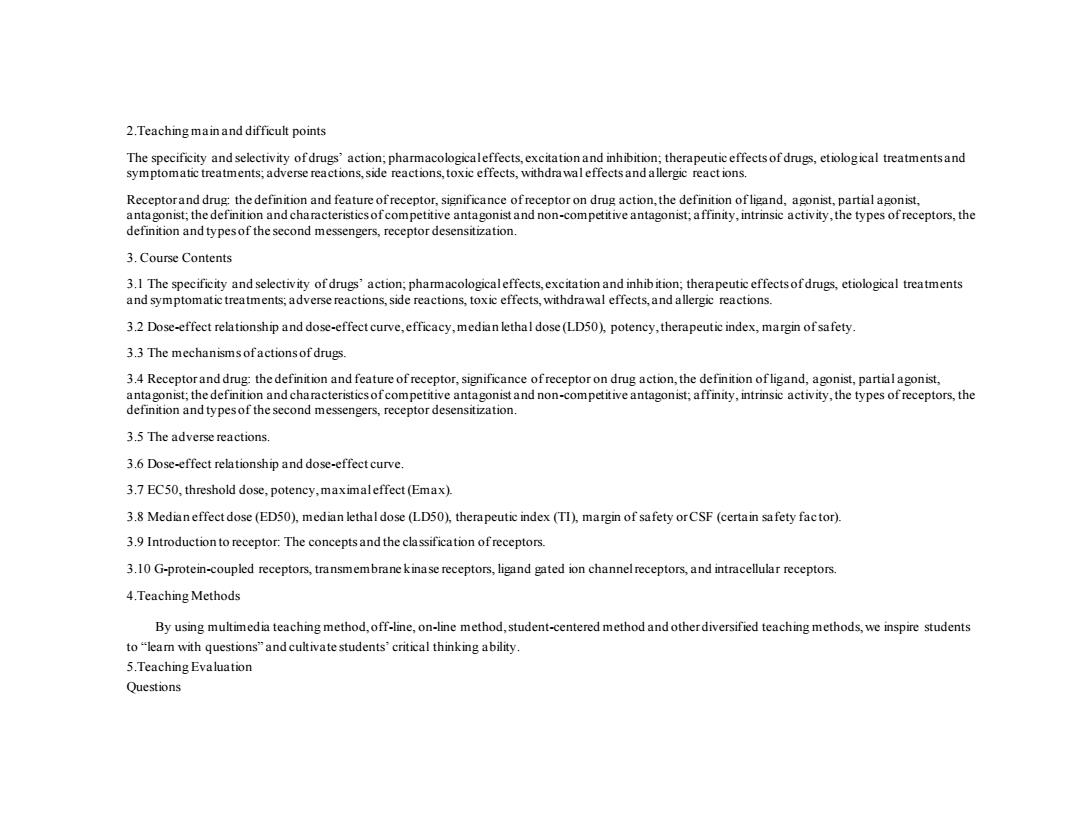
2.Teaching main and difficult points The specificity and selectivity ofdrugs'action;pharmacologicaleffects,excitation and inhibition;therapeutic effects of drugs,etiological treatmentsand symptomatic treatments;adverse reactions,side reactions,toxic effects,withdrawal effectsand allergic react ions. Receptorand drug:the definition and feature ofreceptor,significance ofreceptor on drug action,the definition of ligand,agonist,partial agonist, antagonist;the definition and characteristics ofcompetitive antagonist and non-competitive antagonist,affinity,intrinsic activity,the types ofreceptors,the definition and types of the second messengers,receptor desensitization. 3.Course Contents 3.1 The specificity and selectivity of drugs'action;pharmacologicaleffects,excitation and inhib ition;therapeutic effects ofdrugs,etiological treatments and symptomatic treatments;adverse reactions,side reactions,toxic effects,withdrawal effects,and allergic reactions. 3.2 Dose-effect relationship and dose-effect curve,efficacy,median lethal dose(LD50),potency,therapeutic index,margin of safety 3.3 The mechanisms ofactions of drugs. 3.4 Receptor and drug:the definition and feature of receptor,significance of receptor on drug action,the definition of ligand,agonist,partial agonist, antagonist;the definition and characteristics ofcompetitive antagonist and non-competitive antagonist;affinity,intrinsic activity,the types of receptors,the definition and types of the second messengers,receptor desensitization. 3.5 The adverse reactions. 3.6 Dose-effect relationship and dose-effect curve. 3.7 EC50,threshold dose,potency,maximaleffect(Emax). 3.8 Medianeffect dose(ED50),median lethal dose(LD50),therapeutic index(TI),margin of safety or CSF(certain safety factor). 3.9 Introduction to receptor:The concepts and the classification ofreceptors. 3.10 G-protein-coupled receptors,transmembrane kinase receptors,ligand gated ion channel receptors,and intracellular receptors. 4.Teaching Methods By using multimedia teaching method,off-line,on-line method,student-centered method and other diversified teaching methods,we inspire students to"leam with questions"and cultivate students'critical thinking ability. 5.Teaching Evaluation Questions
2.Teaching main and difficult points The specificity and selectivity of drugs’ action; pharmacological effects, excitation and inhibition; therapeutic effects of drugs, etiological treatments and symptomatic treatments; adverse reactions, side reactions, toxic effects, withdrawal effects and allergic reactions. Receptor and drug: the definition and feature of receptor, significance of receptor on drug action, the definition of ligand, agonist, partial agonist, antagonist; the definition and characteristics of competitive antagonist and non-competitive antagonist; affinity, intrinsic activity, the types of receptors, the definition and types of the second messengers, receptor desensitization. 3. Course Contents 3.1 The specificity and selectivity of drugs’ action; pharmacological effects, excitation and inhib ition; therapeutic effects of drugs, etiological treatments and symptomatic treatments; adverse reactions, side reactions, toxic effects, withdrawal effects, and allergic reactions. 3.2 Dose-effect relationship and dose-effect curve, efficacy, median letha l dose (LD50), potency, therapeutic index, margin of safety. 3.3 The mechanisms of actions of drugs. 3.4 Receptor and drug: the definition and feature of receptor, significance of receptor on drug action, the definition of ligand, agonist, partial agonist, antagonist; the definition and characteristics of competitive antagonist and non-competitive antagonist; affinity, intrinsic activity, the types of receptors, the definition and types of the second messengers, receptor desensitization. 3.5 The adverse rea ctions. 3.6 Dose-effect relationship and dose-effect curve. 3.7 EC50, threshold dose, potency, maximal effect (Emax). 3.8 Median effect dose (ED50), median lethal dose (LD50), therapeutic index (TI), margin of safety or CSF (certain safety fac tor). 3.9 Introduction to receptor: The concepts and the classification of receptors. 3.10 G-protein-coupled receptors, transmembrane kinase receptors, ligand gated ion channel receptors, and intracellular receptors. 4.Teaching Methods By using multimedia teaching method, off-line, on-line method, student-centered method and other diversified teaching methods, we inspire students to “learn with questions” and cultivate students’ critical thinking ability. 5.Teaching Evaluation Questions
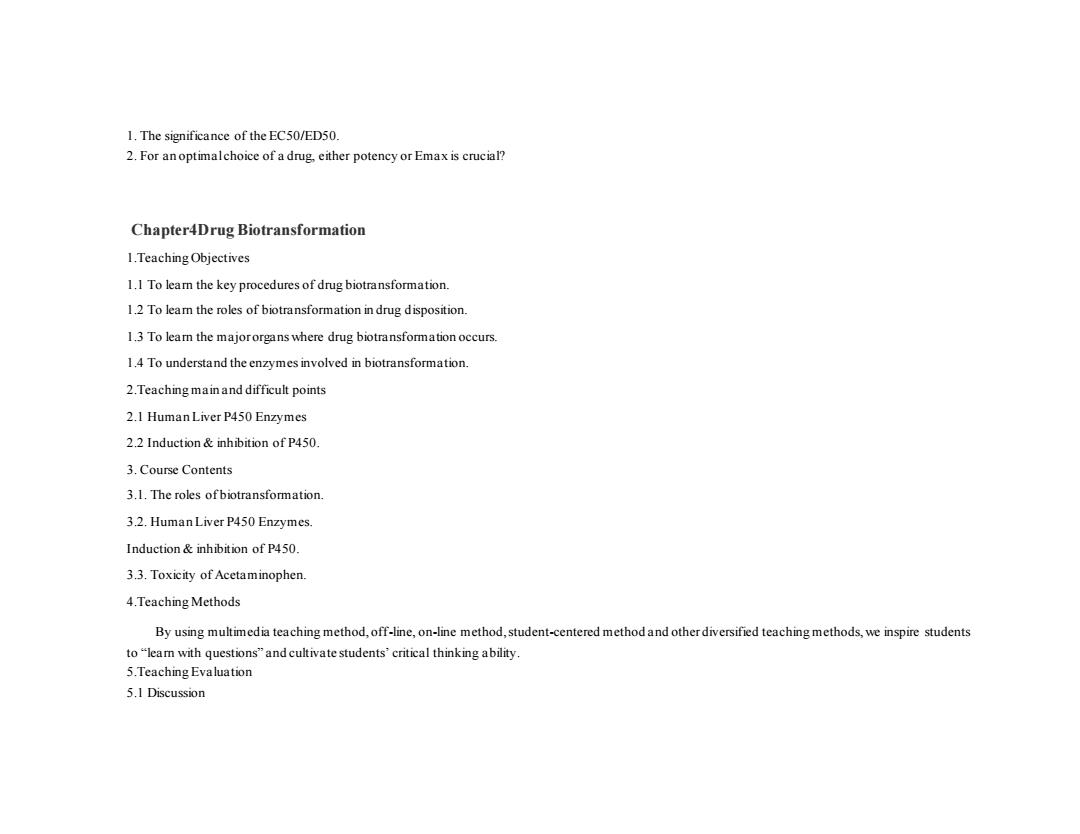
1.The significance of the EC50/ED50. 2.For anoptimalchoice of a drug,either potency or Emax is crucial? Chapter4Drug Biotransformation I.TeachingObjectives 1.1 To leam the key procedures of drug biotransformation. 1.2 To leam the roles of biotransformation in drug disposition 1.3 To leam the majororgans where drug biotransformation occurs. 1.4 To understand the enzymes involved in biotransformation. 2.Teaching main and difficult points 2.1 Human Liver P450 Enzymes 2.2 Induction inhibition of P450. 3.Course Contents 3.1.The roles ofbiotransformation. 3.2.Human Liver P450 Enzymes. Induction inhibition of P450. 3.3.Toxicity of Acetaminophen. 4.Teaching Methods By using multimedia teaching method,off-line,on-line method,student-centered method and other diversified teaching methods,we inspire students to"leam with questions"and cultivate students'critical thinking ability 5.Teaching Evaluation 5.1 Discussion
1. The significance of the EC50/ED50. 2. For an optimal choice of a drug, either potency or Emax is crucial? Chapter4Drug Biotransformation 1.Teaching Objectives 1.1 To learn the key procedures of drug biotransformation. 1.2 To learn the roles of biotransformation in drug disposition. 1.3 To learn the major organs where drug biotransformation occurs. 1.4 To understand the enzymes involved in biotransformation. 2.Teaching main and difficult points 2.1 Human Liver P450 Enzymes 2.2 Induction & inhibition of P450. 3. Course Contents 3.1. The roles of biotransformation. 3.2. Human Liver P450 Enzymes. Induction & inhibition of P450. 3.3. Toxicity of Acetaminophen. 4.Teaching Methods By using multimedia teaching method, off-line, on-line method, student-centered method and other diversified teaching methods, we inspire students to “learn with questions” and cultivate students’ critical thinking ability. 5.Teaching Evaluation 5.1 Discussion